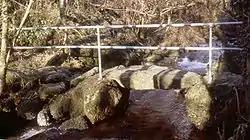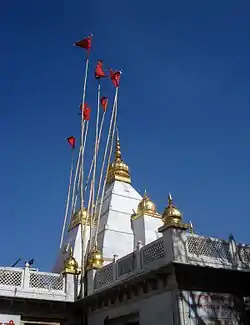2008 Naina Devi temple stampede
The 2008 Naina Devi temple stampede occurred on 3 August 2008 in the Indian state of Himachal Pradesh. 146 people died and 150 were injured when they were crushed, trampled, or forced over the side of a ravine by the movement of a large panicking crowd. Witness accounts suggest that events were initiated after a rain shelter collapsed, which worshipers mistakenly took to be a landslide.[1][2][3] There were as many as 3000 devotees at the temple because it was a sacred place (called a "Shakti Peeth") in the holy month of Shraavana of the Hindu Calendar.[2] According to Daljit Singh Manhas, a senior police officer from the area, at least 40 of the victims were children.[4]
| Date | 3 August 2008 |
|---|---|
| Time | 15:00 IST |
| Location | Bilaspur, Himachal Pradesh |
| Casualties | |
| 146 dead | |
| 150 injured | |
| Stampede, crushed to death, asphyxiation | |
The Chief Minister of Himachal Pradesh, Prem Kumar Dhumal, announced a government compensation of Rs. 100,000 (approximately US$2500) for those who died and Rs. 50,000 (approximately US$1250) for the seriously injured.[5] 50,000 people had been expected to attend Naina Devi during the day of the stampede, as part of a nine-day festival which had just started.[4] The pilgrimage resumed on the next day, 4 August 2008.[6]
Gaurav Singh Saini, a 13-year-old boy from Tohana (a town located near Haryana-Punjab border) Haryana, saved 50-60 people during the stampede, and received the Bharat Award, the highest award at the 2009 National Bravery Awards.[7]
Stampede
Devotees standing in a queue initially saw the collapse of a rain shelter. This triggered a false cry of "landslide!" as it was raining on the day of the stampede.[2] People reportedly tried to move outside the railings put up by the police for crowd control, but the police refused to allow any more movements. The railings later collapsed and people fell on each other, starting the stampede.[6]
Reaction

Rajnath Singh, the current leader of the Bharatiya Janata Party in India, responded to the stampede by releasing a statement in the hours after the disaster. "I am deeply saddened to learn about the tragic death of over 100 pilgrims. I convey my deep felt condolences to the family members of all those who have lost their lives or have been injured in the incident," he said.[8]
Himachal Pradesh Chief Minister Prem Kumar Dhumal responded by announcing an inquiry into the incident.[9]
The Vice President of India, Hamid Ansari, and the Speaker of Lok Sabha, Somnath Chatterjee, conveyed condolences to the families of those killed and injured in the incident.[10][11]
The Tribune criticized the poor infrastructure and ill-maintained roads at the shrine, reporting that a team of doctors and paramedics were unable to reach the site of the accident until hours after the stampede.[12] The Times of India observed that there had been no improvement in crowd management even though a similar stampede took place in the shrine in 1978 after rumors of a landslide spread, killing 65 people.[13] As is often the case during disasters, the mobile telephone network around Naina Devi had insufficient capacity to serve the large number of phone calls by worried relatives.[14]
Post-mortem report of victims
Post-mortem examinations conducted on victims of the Naina Devi temple stampede confirmed that the deaths were caused by asphyxiation. Post-mortem reports of 101 bodies out of a total of 141 victims taken to the civil hospital at Anandpur Sahib in Punjab, 18 km from the site, have indicated compression of the chest causing asphyxiation and death, Sub-Divisional Magistrate (SDM) P C Akela said. Akela, who remained stationed at Anandpur Sahib after the incident, said post-mortems were not carried out on 40 of the dead at the request of their relatives.[15]
See also
References
| Wikinews has related news: |
- Megha Mann; Jai Kumar (3 August 2008). "146 die in Naina Devi stampede". Anandpur Sahib / Bilaspur: The Tribune (India). Retrieved 6 July 2014.
- "'Scores killed' in India stampede". BBC News Online. 3 August 2008. Archived from the original on 3 October 2008. Retrieved 3 August 2008.
- Patil, Gangadhar (15 October 2013). "Madhya Pradesh temple stampede: 27 of 29 stampedes in country in last five years at religious places". dnaIndia.com. New Delhi, India: Diligent Media Corporation. Retrieved 6 July 2014.
- Page, Jeremy (4 August 2008). "More than 100 die in Indian temple stampede". London: Times Online. Retrieved 3 August 2008.
- Sahib, Anandpur. "Stampede at Naina Devi Mandir, 125 feared killed". Himvani. Retrieved 3 August 2008.
- "Naina Devi stampede: Death toll reaches 146, yatra resumes". CNN IBN. 4 August 2008. Archived from the original on 7 August 2008. Retrieved 4 August 2008.
- "21 children to get National Bravery Awards for 2009". Press Trust of India (PTI). 18 January 2010. Archived from the original on 20 January 2010. Retrieved 20 January 2010.
- "BJP expresses shock over death of pilgrims in HP". Chennai, India: The Hindu. 3 August 2008. Retrieved 3 August 2008.
- Jagota, Satish. "HP CM orders magistrial inquiry into Naina Devi stampede". Punjab Newsline. Archived from the original on 12 August 2008. Retrieved 3 August 2008.
- "Vice President expresses shock over loss of lives at stampede". The Times of India. 3 August 2008. Retrieved 3 August 2008.
- "Political reactions". NDTV. Retrieved 4 August 2008.
- Khanna, Mohit. "It was a tragedy waiting to happen". The Tribune(Chandigarh). Archived from the original on 8 August 2008. Retrieved 4 August 2008.
- Bodh, Anand (4 August 2008). "30 years ago, similar tragedy at shrine had claimed 65 lives". The Times of India. Retrieved 4 August 2008.
- Mann, Megha (3 August 2008). "Panicky relatives face mobile network jam". Tribune News Service. Archived from the original on 8 August 2008. Retrieved 4 August 2008.
- "Asphyxiation cause of deaths in temple stampede". The Hindu. Chennai, India. 6 August 2008. Archived from the original on 8 August 2008. Retrieved 7 August 2008.
